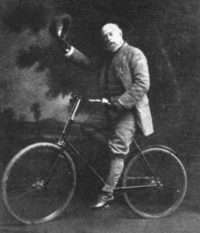Walter Clopton Wingfield
Walter Clopton Wingfield | |
|---|---|
 Wingfield from Illustrated Sporting and Dramatic News 1881 | |
| Born | Walter Clompton Wingfield 16 October 1833 Ruabon, Wales |
| Died | 18 April 1912 (aged 78) London, England |
| Burial place | Kensal Green Cemetery |
Major Walter Clopton Wingfield
Family and early life
Wingfield was born on 16 October 1833 in
During the decade he was based at his family estate, Rhysnant,
In 1870 he was appointed to the Honourable Corps of Gentlemen at Arms, giving him some employment at the courts of Queen Victoria and her son Edward VII. He was invested by King Edward VII as a Member (fourth class) of the Royal Victorian Order (MVO) on 11 August 1902.[5][6] He retired from the Corps in 1909.
Lawn tennis


In the late 1860s Wingfield was one of the persons experimenting with a lawn version of tennis. Vulcanised bouncing rubber balls offered an opportunity to develop from the indoor game of real tennis and there were many who had the leisure time to pursue the sport and who owned croquet lawns that could be adapted for it. The precise date that Wingfield brought it to the public is uncertain. Lord Lansdowne claimed that in 1869 Major Wingfield gave a demonstration of the game to him in the garden of his Berkeley Square house, although in that year Wingfield was not a major. Another attribution was to a party held at Nantclwyd Hall in Denbighshire, Wales, although that party actually took place in December. Nor was Wingfield the only exponent. At the same time, Harry Gem and Augurio Perera were demonstrating their game of Pelota in Leamington Spa.

Wingfield patented a New and Improved Court for Playing the Ancient Game of Tennis and began marketing his game in the spring of 1874 selling boxed sets that included rubber balls imported from Germany as well as a net, poles, court markers, rackets and an instruction manual.[3][7] The sets were available from Wingfield's agent, French and Co. in Pimlico in London, and cost between five and ten guineas. In his version the game was played on an hour-glass shaped court and the net was higher (4 feet 8 inches). The service had to be made from a diamond-shaped box at one end only and the service had to bounce beyond the service line instead of in front of it. He adopted the Rackets-based system of scoring where games consisted of 15 points (called "aces").[4] In order to differentiate his game, he named it Sphairistikè (which was poor Greek using a feminine adjective meaning "pertaining to a ball game" without an appropriate noun.)[3] Between July 1874 and June 1875 1,050 tennis sets were sold, mainly to the aristocracy.[8]
Tennis was becoming an important adjunct to
Later life
Wingfield became vice-president of "The Universal Cookery and Food Association". In around 1890 he founded a culinary society called "Le Cordon Rouge" which was intended to further the development of the science of cookery. At the same time, he was active again as an inventor and experimented with bicycles. He created a new type of bicycle which he called "The Butterfly" and developed a form of bicycling riding in unison by several riders to the tunes of martial music.[3]
On 22 November 1902 Edward VII made Wingfield a member (fourth class) of the Royal Victorian Order (MVO) for "extraordinary, important and personal services to the Sovereign and the Royal family." and for 32 years of faithful service.
Wingfield lived at 112 Belgrave Road,
Wingfield married Alice Lydia Cleveland, daughter of a general. She survived him by many years and died in an asylum in November 1934.[3]
References
- ^ Tyzack, Anna,The True Home of Tennis Country Life, 22 June 2005
- ^ J. Perris (2000) Grass tennis courts: how to construct and maintain them p. 8. STRI, 2000
- ^ ISBN 978-0718501952.
Walter Clopton Wingfield tennis.
- ^ ISBN 9781851243181.
- ^ "Court Circular". The Times. No. 36844. London. 12 August 1902. p. 8.
- ^ "No. 27467". The London Gazette. 22 August 1902. pp. 5461–5462.
- ^ "Wingfield the Mysterious". USTA.
- ISBN 9780719037597.
- ^ "Major Walter Clopton Wingfield 1833-1912 father of lawn tennis lived here". Open Plaques.
- ^ Major Walter Clopton Wingfield International Tennis Hall of Fame
- All England Club. Archived from the originalon 2 July 2015.
Further reading
- George E Alexander (1986). Wingfield : Edwardian Gentleman. Peter Randall Publishing. OCLC 17698782.
